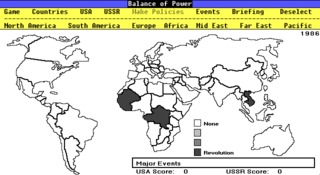Overview
 The DOS version
The DOS versionBalance of Power (also known as Balance of Power: Geopolitics in the Nuclear Age) is a geopolitical turn-based strategy game developed by Chris Crawford and published by Mindscape for Macintosh computers in 1985.
Based on the politics of the then-active Cold War, Balance of Power has players take on the role of either the President of the United States or the General Secretary of the Soviet Union as they attempt to make their superpower the most prestigious in the world through diplomacy and brinkmanship while avoiding escalation to nuclear war. It later received an enhanced revision in 1988, titled Balance of Power: The 1990 Edition.
Balance of Power can be played in single-player (against an A.I. opponent of multiple difficulties) or hotseat multiplayer, with each gameplay lasting a potential of eight turns (each turn representing a year from 1986 to 1993). Intended to be played with mouse controls, the game presents players with a world map showing 62 countries, and can view each country's current statistics, influence, and crises. Both players can then make diplomatic actions in each country (such as providing military or insurgent aid) and make direct responses to the other player's action (putting both players' "prestige" on the line and potentially escalating to nuclear conflict, causing both players to prematurely lose the game).
The game's complexity can be changed by the player as one of four difficulty levels (Beginner, Intermediate, Expert, and Nightmare), with later difficulty levels adding new options (such as destabilizing the region, providing economic aid, putting diplomatic pressure, and forming various treaties) and statistics (such as the "Finlandization" of countries). To improve the game's realism, it features an in-depth statistical database of all countries at the time.
The game was later ported to DOS and Amiga computers in 1986, followed by Atari ST and late Apple II computers in 1987. It was then released by ASCII for MSX, NEC PC-8801, and NEC PC-9801 computers in Japan in 1988-1989. The DOS version is notable for running on top of a standalone Microsoft Windows 1.01 environment (the only known game to do so). As that version can be configured for normal Windows use, it technically makes the game the earliest retail Windows game (and the only known Windows 1.0 retail game), if one doesn't account for the fact that it was not sold for Windows computers.
Along with its updated 2.0 revision, Crawford also applied some of its strategy and simulation aspects into his succeeding game: The Global Dilemma: Guns or Butter. He also released a complementary book in 1986, titled Balance of Power: International Politics as the Ultimate Global Game, which he later released for free on his website. In it, he details the game's history and design decisions. He later revisited the game's concept as a simple demo for his hyperfiction project Storytron, known as Balance of Power: 21st Century.
Log in to comment